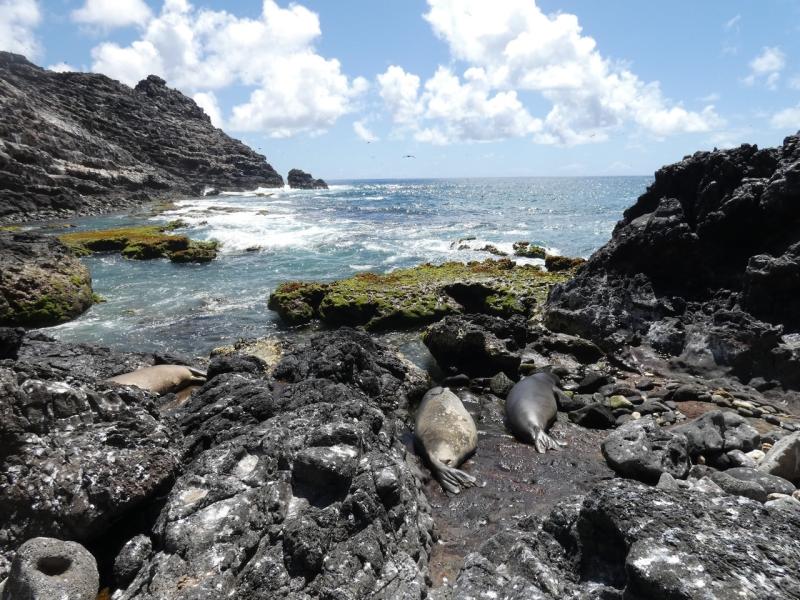Population Size and Trends
The Hawaiian monk seal population has shown some signs of recovery over recent years. The size of the monk seal population in 2019 was about the same as in 2018, with slightly more than 1,400 seals. Most of the population (about 1,100 seals) reside in the remote Northwestern Hawaiian Islands. Just about 300 seals call the main Hawaiian Islands home. While the population size hasn’t really changed since last year, the population trend remains positive in recent years. It has been growing at an average annual rate of 2 percent since 2013. The potential for our continued conservation efforts to make such a positive impact is part of what makes Hawaiian monk seals one of NOAA’s Species in the Spotlight.
NOAA’s Hawaiian Monk Seal Research Program closely tracks these year-to-year population trends, thanks to a robust, long-term dataset. During the 2019 field season, dedicated field biologists lived and worked on remote islands in the Northwestern Hawaiian Islands for 3 to 5 months (depending on the site). In the main Hawaiian Islands, we rely on volunteers, members of the public, and agency partners who contribute to citizen-based seal monitoring.
You can contribute to monitoring Hawaiian monk seals by reporting them at (888) 256-9840.
Pups and Juveniles
Conditions for seal pups and juveniles vary across the archipelago. Seals in some areas are thriving while there is cause for concerns at other sites.
Main Hawaiian Islands
The main Hawaiian Islands saw a record high of 48 pups born in 2019, a particularly good reproductive year. It has been hard to say whether the main Hawaiian Islands seal population was growing or holding steady. The 2019 results provide strong evidence that the number of seals in this region has been growing since at least 2013. Despite these positive signs, we must work to mitigate many human-associated threats to the main Hawaiian Islands monk seal population. These include Toxoplasma, fisheries interactions, and intentional killings. It is notable that in 2019, drowning in fishing nets was the most likely cause of death for three juvenile seals on Oahu’s North Shore. Please follow guidelines for fishing safely around Hawaiʻi wildlife.
Northwestern Hawaiian Islands
Juvenile survival is especially important to monk seal recovery. Surviving the first year or two of life can be one of the biggest hurdles for seals. In recent years, fewer juveniles have survived at several of the Northwestern Hawaiian Islands sites than in past years. This pattern could become a concern if it continues. Our field teams are already starting to prepare for the 2020 research season to better understand these trends and support population recovery.
One Northwestern Hawaiian Islands site, French Frigate Shoals, exemplifies the ups and downs in monk seal conservation. This site has seen major changes with the loss of two important seal pupping islets. One was inundated and the other washed away by Hurricane Walaka in 2018. In 2019, these islets reappeared as tiny sandbars, but still provided limited area for seal pupping.
Loss of safe pupping habitat makes young pups vulnerable to shark predation and drowning in high tide or surf conditions. Our field teams at French Frigate Shoals work hard to translocate pups to islets that offer safer havens for these young seals. There is some good news at French Frigate Shoals, however. In recent years, our teams have found that if the seal pups successfully survive to wean from their mothers, more juveniles survive.
Threat Intervention and Mitigation
We have worked hard with our partners to mitigate threats to monk seals, conducting numerous life-saving interventions to aid population recovery. In 2019, we conducted dozens of interventions to save the lives of monk seals throughout the Hawaiian Archipelago:
- Removing marine debris from 12 entangled seals in the Northwestern Hawaiian Islands, and from two in the main Hawaiian Islands.
- Rescuing five seals from entrapment or drowning in the human-made sea wall at Tern Island, French Frigate Shoals.
- Removing fish hooks from 21 seals in the main Hawaiian Islands.
- Rehabilitating four Northwestern and two main Hawaiian Islands undersized seals at The Marine Mammal Center’s monk seal rehabilitation facility, Ke Kai Ola.
- Translocating 14 pups from areas of high shark predation and nine seals from male seal aggression within atolls in the Northwestern Hawaiian Islands.
- Health interventions such as vaccinating against morbillivirus and treating infections with antibiotics.
- Pup-saving interventions such as reuniting moms and pups that were separated.
We also removed entangling debris from beaches. These actions and other program activities continue to contribute significantly to monk seal recovery at both the individual seal and population level.







